Here is Bimota’s most powerful bike to date, the dramatic hub-centre-steering and supercharged TESI H2 that combines Kawasaki’s supercharged power with Italian design and flair. Our first impression following a first ride at the Modena circuit in Italy.
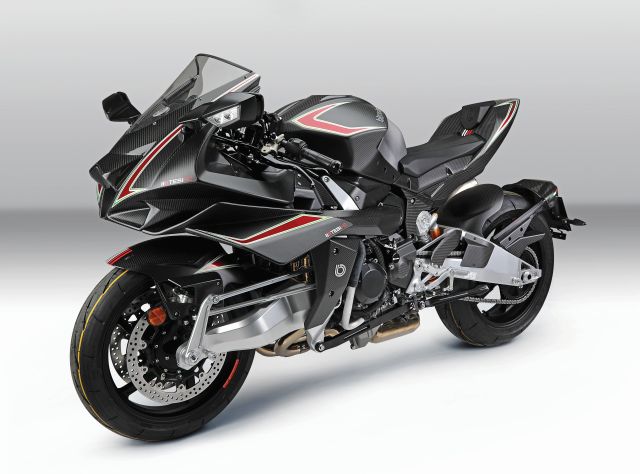
Story: Adam Child ‘Chad’
Let me bring you up to speed. Kawasaki of Japan now own 49.9 per cent of Bimota, which is brilliant news for the small Italian firm. Since its creation in the early 1980s, Bimota has historically bought engines from Kawasaki or Yamaha or Suzuki or Ducati and then produced a bespoke chassis to wrap around those power units. However, developing its fuelling and exhaust systems and then getting the new bike to meet increasingly tough emission regulations was extremely difficult and costly.
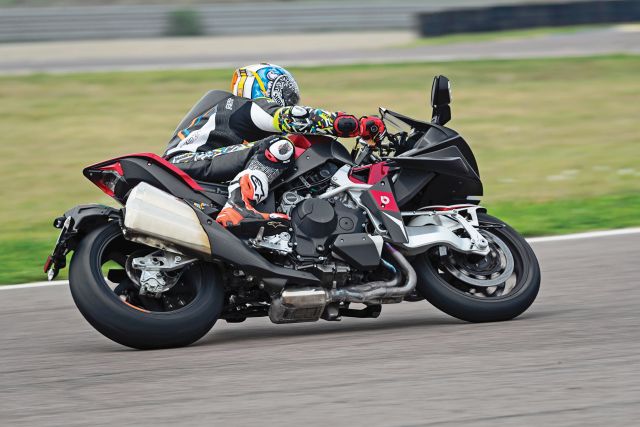
But now, thanks to Kawasaki, Bimota has a colossal amount of engine technology to borrow from its Japanese partners. And this, the TESI H2, is the first bike to come out of this unique and intriguing relationship.
Essentially, Bimota has taken one of the world’s most powerful engines, the supercharged H2, plus its fuelling and exhaust, instruments, switchgear, lights, and electronic rider aids and then added its own chassis and design. Without any fuelling or electronic development costs or Euro-4 compliance to worry about, Bimota’s focus has been centred on what it does best: chassis and design.
Bimota has opted to use its Difazio-type hub-centre-steering TESI front end which was designed by Pierluigi Marconi in the 1980s before reaching production in 1991. The new billet aluminium rear swing-arm and carbon/aluminium front arms get bolted directly to the supercharged Kawasaki motor. Two Öhlins shocks at the rear control the front and rear wheels independently. The conventional trellis Kawasaki frame has been removed.
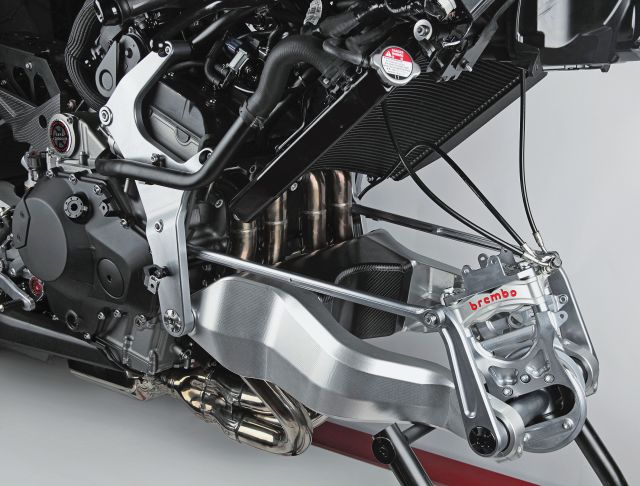
But it is not just about the frame and suspension either. The aerodynamic bodywork, with wings that create high-speed downforce (11 kilograms), plus the fuel-tank are all carbon-fibre. Oh, and this 231-hp motorcycle tops the scales at 207 kg (dry).
We flew out to Italy to test the TESI H2 on track. A price tag of £60,000 (Rs 60 lakh), 231-hp supercharged engine, and unique TESI front end… Bimota certainly knows how to make a statement.
This is where Bimota comes to the party, with its genius chassis design and new TESI front end and hub-centre-steering.
Conventional telescopic forks, especially on powerful bikes like an H2, require enormous strength to deal with the forces of braking, while also performing the more subtle tasks of steering and absorbing bumps. They are attached to a huge (and high) steering head that is braced and stiffened to cope with all those forces passing to the frame. And, of course, they alter the chassis’ wheelbase and steering geometry as they extend and compress.
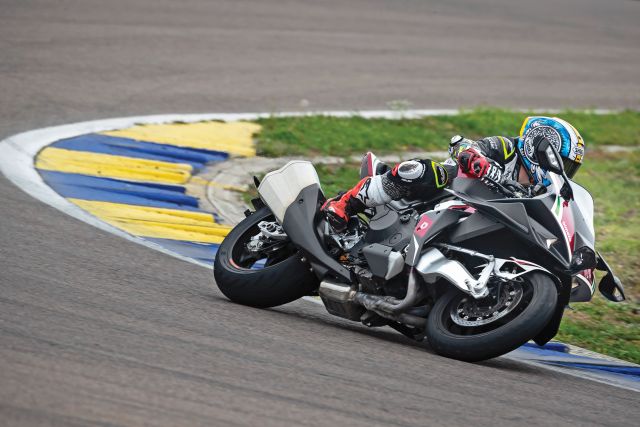
The TESI’s hub-centre-steering system, meanwhile, leaves the geometry unaffected by braking and acceleration. There is not any conventional dive and the feeling at the handlebar is constant, whether the bike is slowing or accelerating or turning.
That is because the functions of braking, suspension, and steering are separated. The steering, for example, is not affected by the suspension, while the suspension is unaffected by braking forces. Each is free of the inherent engineering compromises necessary with teles.
The front suspension is more like a conventional rear swing-arm with a single shock, which, on the Bimota, is located at the rear. Steering is via a series of links and joints, with the front wheel pivoting on a hub (and most of the HCS architecture hidden by dramatic carbon bodywork). In fact, in basic terms the TESI H2 consists of a swing-arm at the front, an engine in the middle, swing-arm at the rear; there is no conventional frame as everything is bolted to Kawasaki’s supercharged motor.
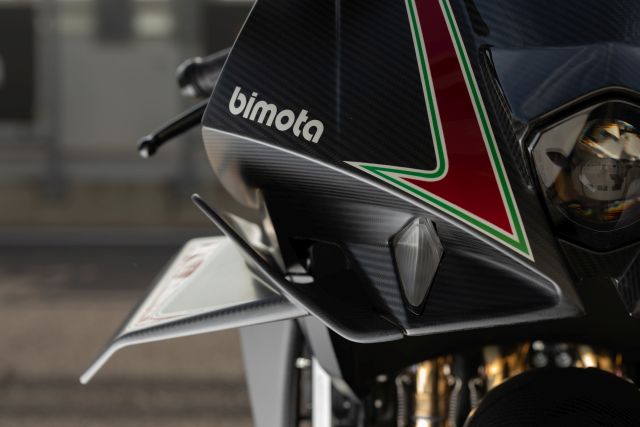
Yes, there is added weight with the additional mechanism and linkages of HCS but that is offset by the absence of a conventional frame and lack of need for a massive headstock. Each arm is made of relatively light billet aluminium with the centre bridge manufactured in carbon-fibre on the front arm.
Rolling out of the pit-lane, the initial feeling was a little odd. When I opened and closed the throttle, the bike was implacable and dive-free. Below 15 km/h it weaved very gently as I counter-steered, trying to get used to the unusual sensation of hub-steering. The initial feeling was vague.
As mentioned, the first session was a little damp as well as cold, so the first few laps were ridden with £60,000 (Rs 60 lakh) worth of circumspection. Soon, however, I started to connect to the different feeling and learned to trust the front-end grip rather than feel for it as I would with teles. Within a few laps, the TESI started to feel natural and I started to feel at home, dragging my knee on the Ferrari test-track with confidence.
By session two, with heat in the Bridgestone rubber and more track familiarity, we properly clicked, in part because of the relative lightness of the Bimota. The quoted kerb wight of the TESI H2 is 219 kg (207 kg dry) while Kawasaki quote a wet weight of 238 kg for the standard H2, which means on paper a significant 19-kg saving with a demonstrably lower centre of gravity too.
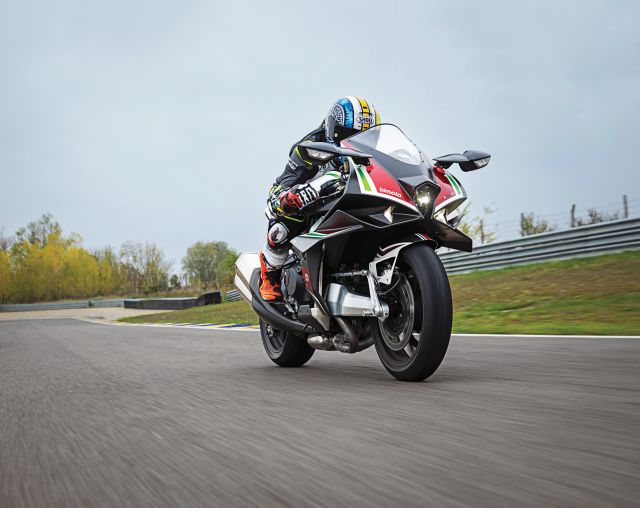
Add to this the fact that the (theoretical) head angle is far steeper on the TESI: 21.3° with 117 millimetres of trail and 24.5° and 103 mm on the Kawasaki. The TESI system allows a much steeper head angle (if Kawasaki were to run such a steep head angle, it would almost buckle the forks) which quickens the steering and makes the TESI even more responsive to rider inputs. There is a sense of lightness engineered into the bike.
In pictures it may look like a big bike, especially with me astride it, and it is indeed on the large side with a taller seat height than the Kawasaki, but it feels much lighter than its Kawasaki donor bike. Considering its brutal power output, the TESI made relatively light work of Modena’s twistiest sections. After a 20-minute session, I did not feel as if I had been in a fight with a heavyweight. Fast direction changes were surprisingly easy, while it flowed accurately and calmly through the faster sections. While it is true that we did not have a standard H2 on the test, I am sure the difference between the two bikes would be significant. I cannot remember the standard H2 feeling this fluid.
Braking is very different from a conventional bike, despite the TESI sharing the same Brembo Stylema calipers as the Kawasaki H2. No matter how hard and late you brake, the TESI stays flat. The front does not dive, you do not run out of fork travel, and the rear does not lift. You can brake exceptionally late yet absolute stability remains; in fact, nothing appears to upset the handling. Corning ABS comes as standard, but its parameters have been changed to match the “funny” front end as well as the bike’s relative lightness and reduced stopping distance.
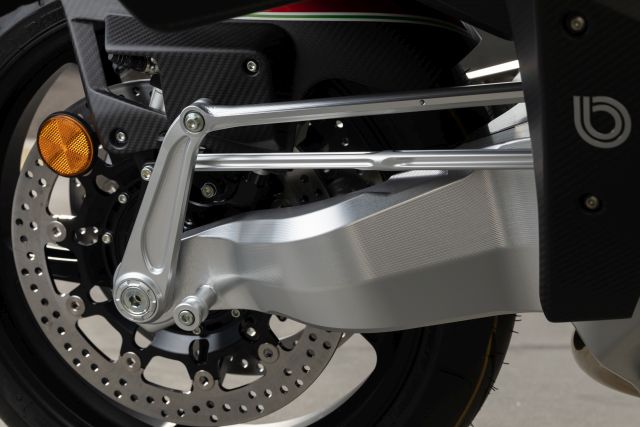
Arguably, there are disadvantages to this system. Without fork dive, the rake stays constant; when you brake heavily, it is not easier to turn as it is on a conventional bike. I would also argue the feeling is not as one-to-one. I did not have the confidence to brake deep into the apex, compressing the front tyre, feeling the sidewall squish and build grip. But this is not a race bike on race tyres and I doubt very much that I would brake deep to the apex on a standard Kawasaki H2 while dragging my knee to the apex.
The more laps I threw in, the more I got used to the feel of the front. I never had an issue with lack of grip or understeer, it worked perfectly and predictably. But I had to build up confidence and in the last 10 per cent I did not quite know how much to push. But I suppose that will build as confidence increases and more set-up time.
Unfortunately, I did not have time to play with the set-up. Clever construction of the suspension support means the ride height can be adjusted by 20 mm without altering the bike’s geometry; instead, you are essentially moving the bike’s centre of gravity. But initial impressions are of a lighter, more flickable machine that can brake later with greater stability.
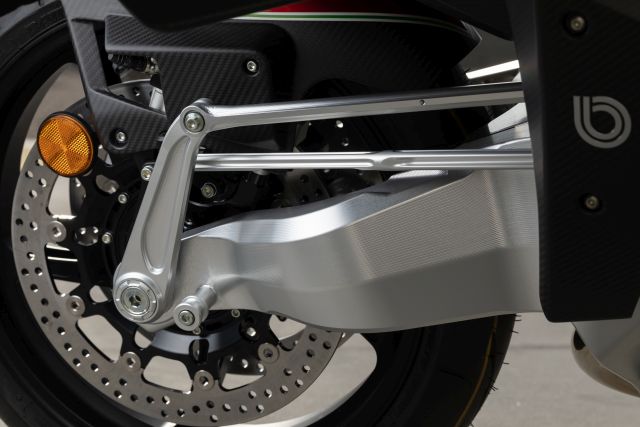
Braking is controlled by twin 330-mm discs, with four-piston Brembo Stylema calipers which are located at the top of the disc, inside the billet aluminium front swing-arm. These are taken directly from Kawasaki. Traditionally, Bimota would locate the calipers on the low side of the disc, at six o’clock, but now they are at 12 o’clock, which, according to Bimota, improves their efficiency.
Braking power is immense; the rear does not lift or come around and the front does not pitch forward. Stability is total, the chassis feels solid. Bimota claims the TESI H2 stops in a shorter distance than the standard Kawasaki H2, so much so that the cornering ABS system and parameters had to be re-calibrated. However, some of this might be down to the lightness of the Bimota and some would argue that, on track, the TESI front end does not give the feedback of a conventional front end.
Kawasaki’s Intelligent anti-lock Brake System (KIS) ABS is present and correct and is linked to the IMU for lean sensitivity. Kawasaki’s engine brake control is also carried over to the Bimota. ABS intervention can be changed but cannot be fully deactivated. On track on standard rubber, the ABS was evident but not too obtrusive.
This is the intriguing aspect of the new partnership between Kawasaki and Bimota. Kawasaki spent a fortune developing the supercharged 998-cc in-line four; perfecting the devilishly complicated fuelling, making sure the technology would be reliable and rideable and making sure it passed tightening homologation regulations for noise and emission. Then Bimota stepped in and scampered off to Italy with all that knowledge and hard work.
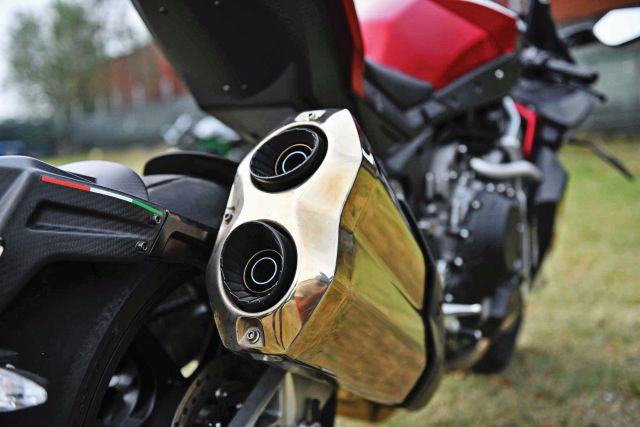
But this does mean that Bimota cannot change any aspect of the engine, including the fuelling and exhaust, because they would then have to start that whole costly process again, including further homologation tests. So, the TESI H2 shares exactly the same supercharged engine as the H2, exactly the same gearbox, fuelling, injectors, and exhaust. It is all identical.
Bimota traditionalists may hesitate, but this is obviously advantageous for Bimota as a huge cost- and time-saving exercise, plus it has a proven 231-hp supercharged reliable motor to deploy as it wishes. The disadvantage is that the current H2 motor is only Euro 4-compliant and the gearbox ratios re-fixed, while that muffler is a little on the bulky side. I am sure the stylish Italians would have given that a tweak if it were possible.
I first rode the legendary H2 and H2R on its world press launch in Qatar and was blown away by the supercharged performance. It was a revelation. I can remember coming in after the first session almost speechless.
Kawasaki have tweaked the motor since 2015 to comply with Euro 4 regulations and this is what powers the Bimota today; but it is still as fierce as ever.
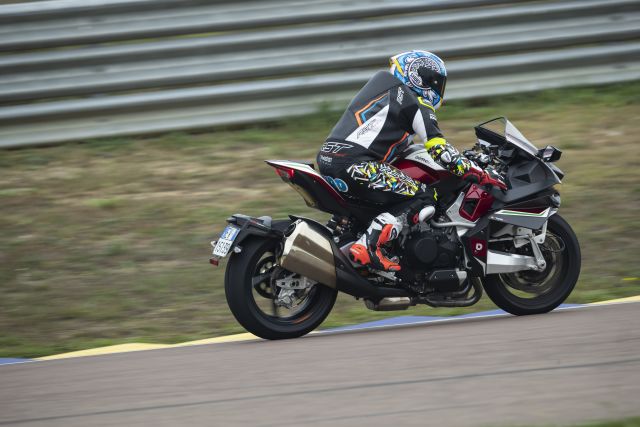
My first session at Modena, a fun but tight track in northern Italy, was a little damp, which meant opting for reduced power and increasing the lean-sensitive traction control. The TESI ran on Bridgestone RS11 rubber and no tyre warmers but within a few laps it was obvious that the grip it was generating was far better than expected. The Bimota runs the same Bosch six-axis IMU as the Kawasaki and it was reassuring to hear the TC working overtime, even with the power reduced.
After a quick pit-stop to change to a dark visor, it was back to normal power and reduced rider aids, a something-in-the-middle setting. Now the H2—sorry, the Bimota—came alive. The supercharged motor has several personalities. The mid-range whoosh is phenomenal and it requires a mental re-calibration to get used to the supercharged delivery. The sheer avalanche of horsepower asks serious questions of the mechanical grip and makes the traction and anti-wheelie work overtime. So, while many bikes make Modena feel tight in places, the Bimota’s Kawasaki power made it feel like a car park.
The only place to really let the TESI H2 loose was down the main straight and, again, the power was almost too much, the acceleration fierce enough to punch the air from your lungs. The kick it delivers is addictive, like nothing else on the road, and acoustically backed up by the chirp of the supercharger.
The rider aids are the same as the H2’s but have been re-calibrated to compensate for the Italian’s comparative lack of weight, which is apparent in everything the bike does. After all, while quoted power is the same as the H2’s, the Bimota is considerably lighter (by 19 kg) and, therefore, accelerates even faster. And if you have ever been lucky enough to sample an H2 off the lead, then you may find that hard to believe.
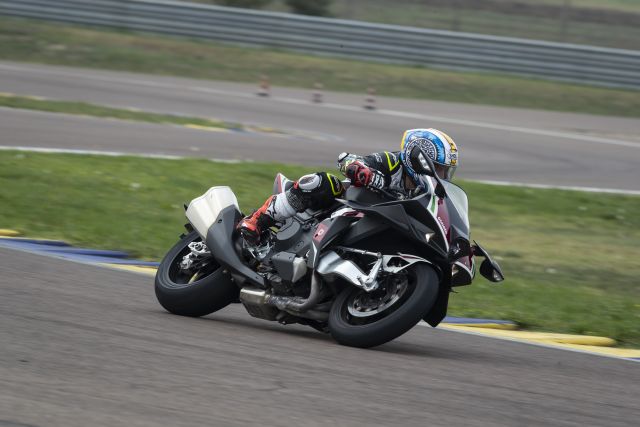
The TESI H2 is far better suited to big circuits like Silverstone or Mugello but the Modena did highlight the Bimota’s downside (which is the same as the H2’s): the fuelling low down is sharp. Yes, you can play with this, changing the engine modes and increasing TC and anti-wheelie helps, but there is no denying the fact that it is a little aggressive when you open the throttle at low revolutions per minute (rpm).
From 20 per cent to 40 per cent throttle, it is just about acceptable, but from 0 per cent to 20 or 30 per cent, it is snappy. The twisty track exacerbated this weakness, meaning you need those excellent rider aids as a safety net as it is hard to dial in the power smoothly and slowly in a low gear. In fact, it is sometimes easier to short-shift on the standard quick-shifter into a taller gear for a better ride
I suppose nothing is perfect. Perhaps, it is too much to expect a market-leading mid-range drive, complete with the cheeky chirp of a supercharger, as well as easily manageable torque low down. But I have ridden the H2 and H2R on fast and flowing tracks and the experience was literally breathtaking. Now I cannot wait to try the Bimota at a faster track.
I do not think the design team had much of a conversation about comfort and fuel economy. However, the Bimota is road-legal and the light handling I felt on track should transfer to the road. The seat height is higher than the H2’s but can be changed by altering the ride height and the pegs are also multi-adjustable.
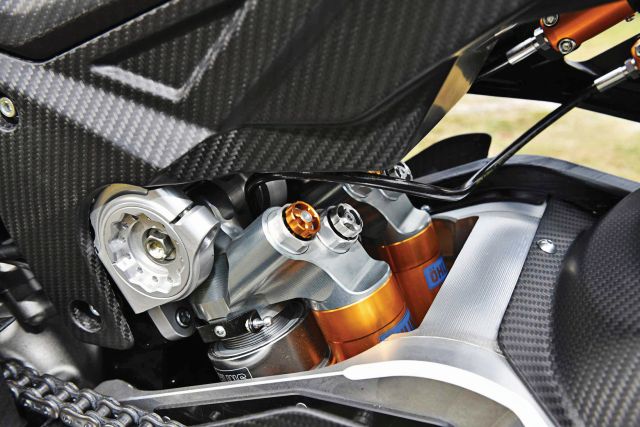
The suspension is fully adjustable, with both remote pre-load adjusters located at the rear of the bike. The TESI front end should, in theory, be well-suited to the road, as braking does not compress the suspension, meaning braking over bumps should feel smoother and plusher.
As noted, the Bimota shares the same fuelling as the H2’s and even the same 17-litre fuel-tank. Range and km/l should be similar, if not slightly better on the Bimota, for it is lighter and, possibly, more aerodynamic. But, like the H2, the Bimota will be thirsty, returning 14 km/l at best, and considerably less on track. All said, if you are buying a £60,000 (Rs 60 lakh) exotic superbike and thinking about running cost and comfort, you probably need to head to the nearest BMW dealership.
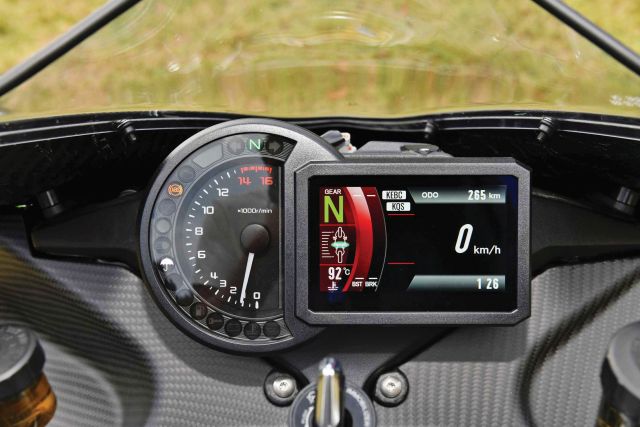
As you are probably able to predict, rider aids have been lifted straight from Kawasaki’s H2 but re-calibrated to match the lighter Bimota. These are linked to a six-axis IMU. This means the TESI H2 comes with proven technology comprising Kawasaki Cornering Management Function (KCMF), Kawasaki Traction Control (KTRC), Kawasaki Launch Control Mode (KLCM), Kawasaki Engine Brake Control, Kawasaki Intelligent anti-lock Brake System (KIBS), ABS, and Dual-direction Kawasaki Quick Shifter (KQS). Bimota has even retained the economical riding indicator. The instruments are again from Kawasaki and their latest light-sensitive TFT displays.
Bimota offers a full race exhaust, which looks stunning and shaves off 14 kg while adding five more hp.
The Bimota TESI H2 is a very difficult bike to judge and to give a categorical verdict because it is so different from anything in the market. Judging by social media alone, some already hate the looks and “funny” front end based on styling alone…
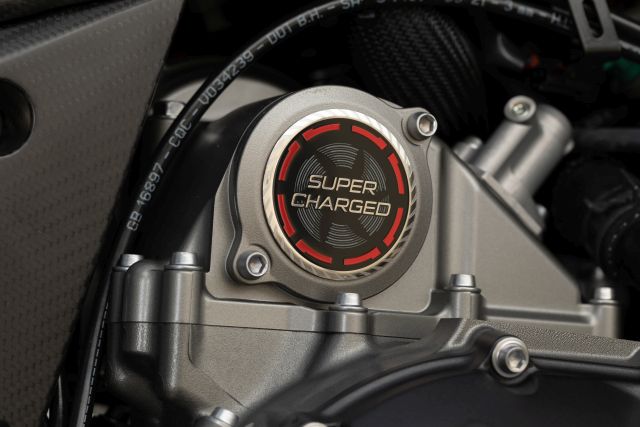
For me, Bimota has taken one of the world’s best engines, Kawasaki’s supercharged H2, and housed it in a unique chassis, which feels lighter and more agile than the all-Japanese bike. The Italians have then added their own flair, style, and design—and I love the fact it looks like no other bike on the planet. Yes, it is expensive, but production is going to be limited to 250 and is in line to become a future classic.
The TESI H2 is not for everyone. Some will not click with the hub-centre steering and the differences it brings and the fuelling is aggressive at low speed, which, on the road, will be far from ideal. And if you have £60,000 (Rs 60 lakh), there are cheaper bikes that are faster around a racetrack.
I applaud what Bimota has done. It is wonderful that there are designers who are still out there pushing the boundaries and producing something that not only works but looks fantastic.
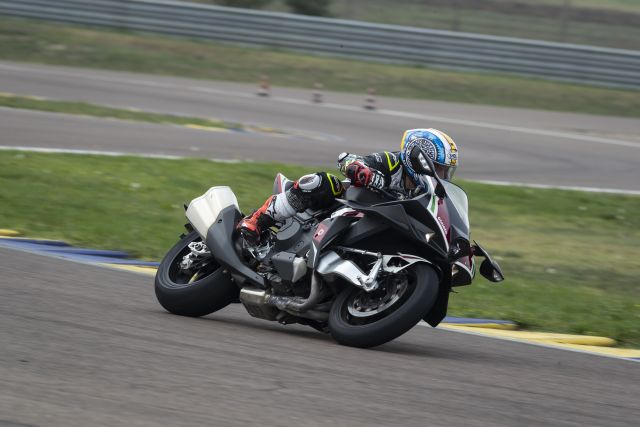
If your favourite colour is grey and you get excited about golf, the TESI is not for you. If you want big power, a bold statement, and do not care about km/l or the fact that there are bikes that are more capable on track, then the TESI is for you. I cannot think of any other bike which shouts ‘Look at me!’ any louder. It is a bold, brilliant Kawasaki H2 smothered in Italian style and engineering brilliance. Who wants normal?
Technical Specification
Bimota TESI H2
Price: £60,000 (Rs 60 lakh)
Capacity: 998 cc
Bore x Stroke: 76 x 55 mm
Engine: Water-cooled, supercharged, in-line four-cylinder
Valves: DOHC, four valves/cyl
Power: 231 hp at 11,500 rpm (242 hp with Ram Air)
Torque: 141.7 Nm at 11,000 rpm
Top speed: 300 km/h (estimated)
Transmission: Six-speed, up/down quick-shifter
Tank size: 17 litres
Rider aids: Three engine maps, nine levels of lean-sensitive traction control (including wheelie and slide control), lean-sensitive ABS, up and down quick-shifter, launch control, and engine brake control
Frame: Billet-machined aluminium plates on to the engine
Front suspension: Billet aluminium alloy swingarm, 100-mm travel, Öhlins TTX 36, fully adjustable
Rear suspension: Billet aluminium alloy swingarm, 130-mm travel, Öhlins TTX36, fully adjustable
Front brake: Twin 330-mm discs, Brembo four-pot calipers, Cornering ABS
Rear brake: 220-mm disc, Brembo two-pot caliper, Cornering ABS
Front wheel: 3.50 x 17-inch, alloy
Front tyre: 120/70 ZR17, Bridgestone RS11
Rear wheel: 6.00 x 17-inch, alloy
Rear tyre: 200/55 ZR17, Bridgestone RS11
Wheelbase: 1,455 mm
Seat height: 840 mm (+/- 10-mm ride height)
Weight: 207 kg (dry), 219 kg (kerb)


Leave a Reply